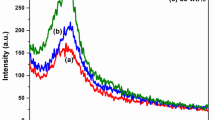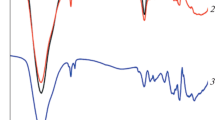Abstract
Structural, optical and dielectric properties of polypyrrole (Ppy) were studied. Structural and optical properties of Ppy were studied using FT-IR and UV–visible spectrophotometer. Optical band gap (\(E_{g}\)) values of Ppy in an ionic liquid were increased with composite raw material. Moreover, the relation between (\(E_{g}\)) and refractive index (n) was estimated by Moss relation and then the relation between n and optical high-frequency dielectric constant (\(\varepsilon^{{\prime }}\)) were calculated. The experimental dielectric constant values of Ppy were lower than the theoretical values calculated from the relation. The alternating current (ac) conductivity shows that the compound is a typical organic semiconductor, as its conductivity increases with increasing frequency and the obtained results have been discussed in terms of the correlated barrier hopping (CBH) model. The absorption coefficient effects of the Ppy samples exhibited nearly-Debye type process. The calculated α and τ 0 values are ~0.14 and ~0.01587 s, respectively.










Similar content being viewed by others
References
Sacramento E, Lima L, Oliveira CJ et al (2008) Hydrogen energy system and prospects for reducing emissions of fossil fuels pollutants in the Ceara state Brazil. Int J Hydrogen Energy 33:2132–2137
Midilli A, Dincer I (2008) Hydrogen as a renewable and sustainable solution in reducing global fossil fuel consumption. Int J Hydrogen Energy 33:4209–4222
Plantard G, Goetz V, Correia F et al (2011) Importance of a medium’s structure on Photocatalysis using TiO2-coated foams. Sol Energy Mater Sol Cells 95:2437–2442
Belabed C, Haine N, Benabdelghani Z et al (2014) Photocatalytic hydrogen evolution on the hetero-system polypyrrol/TiO2 under visible light. Int J Hydrogen Energy 39:17533–17539
Yakuphanoglu F, Yahiaa S, Senkal B et al (2011) Impedance spectroscopy properties of polypyrrole doped with boric acid. Synth Met 161:817–822
Yakuphanoglu F, Senkal B (2009) Electrical conductivity and optical properties of poly (3-thiophene boronic acid) organic semiconductor. Polym Eng Sci 49:722–726
Yakuphanoglu F, Senkal B (2010) Electrical characterization of the boron trifluoride doped poly (3-aminoacetophenone)/p–Si junction. Polym Eng Sci 50:929–935
Cíka G, Dlhán L, Sersen F et al (2009) Interactions of polarons in poly(3-dodecythiophene) at low temperature. Synth Met 159:613–618
Özyılmaz A, Erbil M, Yazıcı B (2006) The electrochemical synthesis of polyaniline on stainless steel and its corrosion performance. Curr Appl Phys 6:1–9
Skotheim T, Reynolds J (2007) Handbook of conducting polymers: part 1: theory, synthesis, properties, and characterization, and part 2: processing and application. CRC Press, Taylor and Francis Group, New York
Utz W, Förmer W (1998) Polarons and bipolarons in cis-polyacetylene. Phys Rev B 57:10512–10525
Velhal N, Patil N, Puri V (2015) In situ polymerization and characterization of highly conducting polypyrrole fish scales for high-frequency applications. J Electron Mater 44:4669–4675
Velhal N, Patil N, Jamdade S et al (2014) Studies on galvanostatically electropolymerised polypyrrole/polyaniline composite thin films on stainless steel. Appl Surf Sci 307:129–135
Bobacka J, Ivaska A, Lewenstam A (2008) Potentiometric ion sensors. Chem Rev 108:329–351
Wang L, Li G, Yang L (2001) Preparation properties and applications of polypyrroles. React Funct Polym 47:125–139
Fattoum A, Arous M, Gmati F et al (2007) Magnetic properties of Ba-M-type hexagonal ferrites prepared by the sol–gel method with and without polyethylene glycol added. J Phys D Appl Phys 40:4347–4355
Pope M, Swenberg E (1999) Electronic processes in organic crystals and polymers. Oxford University Press, Oxford
Thombare JV, Rath MC, Han S et al (2013) Synthesis of hydrophilic polypyrrole thin films by silar method. Mater Phys Mech 16(2013):118–125
Hazarika J, Kumar A (2016) Studies of structural, optical, dielectric relaxation and ac conductivity of different alkylbenzenesulfonic acids doped polypyrrole nanofibers. Phys B 481:268–279
Carroll D, Czerw R, Webster S (2005) Polymer–nanotube composites for transparent, conducting thin films. Synth Met 155:694–697
Gürbüz O, Kurt I, Güner S et al (2015) Influence of Al concentration and annealing temperature on structural, optical, and electrical properties of Al co-doped ZnO thin films. Appl Surf Sci 349:549–560
Aziz S, Ahmed H, Hussein M et al (2015) Tuning the absorption of ultraviolet spectra and optical parameters of aluminum doped PVA based solid polymer composites. J Mater Sci 26:8022–8028
Dalmolin C, Biaggio S, Bocchi N (2014) Changes of electrochemical properties of polypyrrole when synthesized in a room-temperature ionic liquid. Mater Chem Phys 147:99–104
Reddy R, Ahammed Y (1995) A study on the Moss relation. Infrared Phys Technol 36:825–830
Gassoumi A, Alleg S, Kamoun-Turki N (2016) Influencing the structural, microstructural and optical properties of PbS nanocrystalline thin films by Mg2+ doping. J Mol Struct 1116:67–71
Hannachi L, Bouarissa N (2009) Band parameters for cadmium and zinc chalcogenide compounds. Phys B 404:3650–3655
Wang M, Dong S (2007) Enhanced electrochemical properties of nanocomposite polymer electrolyte based on copolymer with exfoliated clays. J Pow Source 170:425–432
Gürbüz O, Okutan M (2016) Structural, electrical, and dielectric properties of Cr doped ZnO thin films: role of Cr concentration. Appl Surf Sci 387:1211–1218
Aahokkumar M, Muthukumaran S (2015) Electrical, dielectric, photoluminescence and magnetic properties of ZnO nanoparticles co-doped Co and Cu. J Magn Magn Mater 374(2015):61–66
Ali I, Islam M, Ashiq M et al (2013) Effect of Tb–Mn substitution on DC and AC conductivity of Y-type hexagonal ferrite. J Alloy Compd 579:576–582
Bai Y, Zhou J, Gui Z et al (2004) Electrical properties of non-stoichiometric Y-type hexagonal ferrite. J Magn Magn Mater 278:208–213
Cole K, Cole R (1941) Dispersion and absorption in dielectrics, I. Alternating current characteristics. J Chem Phys 9:341–349
Chourashiya M, Patil J, Pawar S et al (2008) Studies on structural, morphological and electrical properties of Ce1−x Gd x O2−(x/2). Mater Chem Phys 109:39–44
Karamata N, Ali I, Aziz A et al (2015) Electrical and dielectric studies of substituted holmium based pyrochlore zirconates nanomaterials. J Alloy Compd 652:83–90
Sindhu S, Anantharaman M, Thampi B et al (2002) Evaluation of ac conductivity of rubber ferrite composites from dielectric measurements. Bull Mater Sci 25:599–607
Yalçın O, Coşkun R, Okutan M (2013) Comparison effects and dielectric properties of different dose methylene-blue-doped hydrogels. J Phys Chem B 117:8931–8934
Batoo K, Kumar S, Lee C et al (2009) Finite size effect and influence of temperature on electrical properties of nanocrystalline Ni–Cd ferrites. Curr Appl Phys 9:1072–1078
Jonscher A (1977) The “universal” dielectric response. Nature 267:673–679
Böttger H, Bryksin V (1985) Hopping conduction in solids. Akademie, Berlin
Benali A, Bejar M, Dhahri E et al (2015) Electrical conductivity and ac dielectric properties of La0.8Ca0.2−x Pb x FeO3 (x = 0.05, 0.10 and 0.15) perovskite compounds. J Alloy Compd 653:506–512
Barsoukov E, Macdonald J (2005) Impedance spectroscopy theory, experiment and applications. Second edition Wiley Inter science, New York, p 14
Tohumcu C, Taş R, Can M (2014) Increasing the crystallite and conductivity of polypyrrole with dopant used. Ionics 20:1687–1692
Angell C (1983) Fast ion motion in glassy and amorphous materials. Solid State Ionics 9–10:3–16
Mott N, Davis E (1979) Electronic processes in non-crystalline materials, 2nd edn. Clarendon Press, Oxford
Dhahri A, Rhou F, Dhahri J et al (2011) Structural and electrical characteristics of rare earth simple perovskite oxide. Solid State Commun 151:738–742
Pouch J, Alterovitz S (1990) Synthesis and properties of boron nitride. Trans Techn, Brookfield
Balarew C, Duhlew R (1984) Application of the hard and soft acids and bases concept to explain ligand coordination in double salt structures. J Solid State Chem 55:1–6
Wagner K (1913) The theory of heterogeneous dielectric. Ann Phys 40:817–855
Şentürk E, Okutan M, San S et al (2008) Debye type dielectric relaxation in carbon nano-balls’ and 4-DMAABCA acid doped E7 coded nematic liquid crystal. J Non Cryst Solids 354:3525–3528
Acknowledgements
This work was supported by the Scientific Research Fund of Yıldız Technical University under Project Number: 2015-01-01-KAP08.
Author information
Authors and Affiliations
Corresponding author
Rights and permissions
About this article
Cite this article
Gürbüz, O., Şenkal, B.F. & İçelli, O. Structural, optical and electrical properties of polypyrrole in an ionic liquid. Polym. Bull. 74, 2625–2639 (2017). https://doi.org/10.1007/s00289-016-1856-3
Received:
Revised:
Accepted:
Published:
Issue Date:
DOI: https://doi.org/10.1007/s00289-016-1856-3




